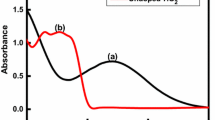Abstract
In this paper, dye-sensitized TiO2 electrodes were immersed into a solution of aluminum isopropoxide and after hydrolysis quasi-solid state solar cells were fabricated. The interaction between the dye and the resulting Al2O3 overlayer was investigated by ultraviolet-visible (UV-vis) spectrum and X-ray photoelectron spectrum (XPS). I-V characteristics showed that the overlayer greatly increased photovoltage and slightly decreased photocurrent under irradiation of low intensity, and increased both photovoltage and photocurrent under AM 1.5 irradiation. The Al2O3 overlayer at the dye/electrolyte interface results in a 28% improvement in overall photo-to-electrical conversion efficiency from 2.60% to 3.32% under illumination of light intensity 100 mW/cm2. Dark current measurements show that Al2O3 acting as insulator barriers to retard recombination between TiO2, dye/quasi-solid state electrolyte interface.
Access this chapter
Tax calculation will be finalised at checkout
Purchases are for personal use only
Preview
Unable to display preview. Download preview PDF.
Similar content being viewed by others
References
O’Regan, B.; Gratzel, M., A low-cost, high-efficiency solar cell based on dye-sensitized colloidal TiO2 films. Nature 1991,353, 737–740.
Gratzel, M., Conversion of sunlight to electric power by nanocrystalline dye-sensitized solar cells. Journal Of Photochemistry And Photobiology A-Chemistry 2004,164,(1–3), 3–14.
Kuang, D. B.; Klein, C.; Ito, S.; Moser, J. E.; Humphry-Baker, R.; Zakeeruddin, S. M.; Gratzel, M., High molar extinction coefficient ion-coordinating ruthenium sensitizer for efficient and stable mesoscopic dye-sensitized solar cells. Advanced Functional Materials 2007,17,(1), 154–160.
Hu, L. H.; Dai, S. Y.; Weng, J.; **ao, S. F.; Sui, Y. F.; Huang, Y.; Chen, S. H.; Kong, F. T.; Pan, X.; Liang, L. Y.; Wang, K. J., Microstructure design of nanoporous TiO2 photoelectrodes for dye-sensitized solar cell modules. Journal Of Physical Chemistry B 2007, 111,(2), 358–362.
Karthikeyan, C. S.; Peter, K.; Wietasch, H.; Thelakkat, M., Highly efficient solid-state dye-sensitized TiO2 solar cells via control of retardation of recombination using novel donor-antenna dyes. Solar Energy Materials And Solar Cells 2007, 91,(5), 432–439.
Montanari, I.; Nelson, J.; Durrant, J. R., Iodide electron transfer kinetics in dye-sensitized nanocrystalline TiO2 films. Journal Of Physical Chemistry B 2002,106,(47), 12203–12210.
Kay, A.; Gratzel, M., Dye-sensitized core-shell nanocrystals: Improved efficiency of mesoporous tin oxide electrodes coated with a thin layer of an insulating oxide. Chemistry Of Materials 2002, 14,(7), 2930–2935.
Palomares, E.; Clifford, J. N.; Haque, S. A.; Lutz, T.; Durrant, J. R., Control of charge recombination dynamics in dye sensitized solar cells by the use of conformally deposited metal oxide blocking layers. Journal Of The American Chemical Society 2003, 125,(2), 475–482.
Wang, P.; Wang, L. D.; Ma, B. B.; Li, B.; Qiu, Y., TiO2 surface modification and characterization with nanosized PbS in dye-sensitized solar cells. Journal Of Physical Chemistry B 2006, 110,(29), 14406–14409.
Liu, Z. Y.; Pan, K.; Liu, M.; Wang, M. J.; Lu, Q.; Li, J. H.; Bai, Y. B.; Li, T. J., Al2O3-coated SnO2/TiO2 composite electrode for the dye-sensitized solar cell. ElectrochimicaActa 2005, 50,(13), 2583–2589.
Zhang, X. T.; Sutanto, I.; Taguchi, T.; Meng, Q. B.; Rao, T. N.; Fujishima, A.; Watanabe, H.; Nakamori, T.; Uragami, M., Al2O3-coated nanoporous TiO2 electrode for solid-state dye-sensitized solar cell. Solar Energy Materials And Solar Cells 2003, 80,(3), 315–326.
Taguchi, T.; Zhang, X. T.; Sutanto, I.; Tokuhiro, K.; Rao, T. N.; Watanabe, H.; Nakamori, T.; Uragami, M.; Fujishima, A., Improving the performance of solid-state dye-sensitized solar cell using MgO-coated TiO2 nanoporous film. Chemical Communications 2003, (19), 2480–2481.
Chen, S. G.; Chappel, S.; Diamant, Y.; Zaban, A., Preparation of Nb2O5 coated TiO2 nanoporous electrodes and their application in dye-sensitized solar cells. Chemistry Of Materials 2001, 13,(12), 4629–4634.
Wang, P.; Wang, L. D.; Li, B.; Qiu, Y., Improved voltage and fill factor by using zinc oxide thin film as a barrier layer in dye-sensitized solar cells. Chinese Physics Letters 2005, 22,(10), 2708–2710.
Menzies, D. B.; Cervini, R.; Cheng, Y. B.; Simon, G. P.; Spiccia, L., Nanostructured ZrO2-coated TiO2 electrodes for dye-sensitised solar cells. Journal Of Sol-Gel Science And Technology 2004, 32,(1–3), 363–366.
Kroeze, J. E.; Hirata, N.; Koops, S.; Nazeeruddin, M. K.; Schmidt-Mende, L.; Gratzel, M.; Durrant, J. R., Alkyl chain barriers for kinetic optimization in dye-sensitized solar cells. Journal of the American Chemical Society 2006, 128,(50), 16376–16383.
Clifford, J. N.; Palomares, E.; Nazeeruddin, K.; Thampi, R.; Gratzel, M.; Durrant, J. R., Multistep electron transfer processes on dye co-sensitized nanocrystalline TiO2 films. Journal Of The American Chemical Society 2004, 126,(18), 5670–5671.
Wang, Z. S.; Sugihara, H., N3-sensitized TiO2 films: In situ proton exchange toward open-circuit photovoltage enhancement. Langmuir 2006, 22,(23), 9718–9722.
Li, B.; Wang, L. D.; Zhang, D. Q.; Qiu, Y., Preparation and characterization of compact TiO2 film used in Gratzel solar cells. Chinese Science Bulletin 2004,49,(2), 123–127.Z
Zhang, X. T.; Liu, H. W.; Taguchi, T.; Meng, Q. B.; Sato, O.; Fujishima, A., Slow interfacial charge recombination in solid-state dye-sensitized solar cell using Al2O3-coated nanoporous TiO2 films. Solar Energy Materials And Solar Cells 2004, 81,(2), 197–203.
Author information
Authors and Affiliations
Editor information
Editors and Affiliations
Rights and permissions
Copyright information
© 2008 Tsinghua University Press, Bei**g and Springer-Verlag GmbH Berlin Heidelberg
About this paper
Cite this paper
Luo, F., Wang, L., Ma, B., Qiu, Y. (2008). Alumina Post-Modification After Dye-Sensitization: Effect on the Performance of Quasi-Solid State Solar Cells. In: Goswami, D.Y., Zhao, Y. (eds) Proceedings of ISES World Congress 2007 (Vol. I – Vol. V). Springer, Berlin, Heidelberg. https://doi.org/10.1007/978-3-540-75997-3_255
Download citation
DOI: https://doi.org/10.1007/978-3-540-75997-3_255
Publisher Name: Springer, Berlin, Heidelberg
Print ISBN: 978-3-540-75996-6
Online ISBN: 978-3-540-75997-3
eBook Packages: EngineeringEngineering (R0)




